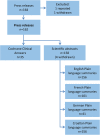Languages for different health information readers: multitrait-multimethod content analysis of Cochrane systematic reviews textual summary formats
- PMID: 30953453
- PMCID: PMC6451281
- DOI: 10.1186/s12874-019-0716-x
Languages for different health information readers: multitrait-multimethod content analysis of Cochrane systematic reviews textual summary formats
Abstract
Background: Although subjective expressions and linguistic fluency have been shown as important factors in processing and interpreting textual facts, analyses of these traits in textual health information for different audiences are lacking. We analyzed the readability and linguistic psychological and emotional characteristics of different textual summary formats of Cochrane systematic reviews.
Methods: We performed a multitrait-multimethod cross-sectional study of Press releases available at Cochrane web site (n = 162) and corresponding Scientific abstracts (n = 158), Cochrane Clinical Answers (n = 35) and Plain language summaries in English (n = 156), French (n = 101), German (n = 41) and Croatian (n = 156). We used SMOG index to assess text readability of all text formats, and natural language processing tools (IBM Watson Tone Analyzer, Stanford NLP Sentiment Analysis and Linguistic Inquiry and Word Count) to examine the affective states and subjective information in texts of Scientific abstracts, Plain language summaries and Press releases.
Results: All text formats had low readability, with SMOG index ranging from a median of 15.6 (95% confidence interval (CI) 15.3-15.9) for Scientific abstracts to 14.7 (95% CI 14.4-15.0) for Plain language summaries. In all text formats, "Sadness" was the most dominantly perceived emotional tone and the style of writing was perceived as "Analytical" and "Tentative". At the psychological level, all text formats exhibited the predominant "Openness" tone, and Press releases scored higher on the scales of "Conscientiousness", "Agreeableness" and "Emotional range". Press releases had significantly higher scores than Scientific abstracts and Plain language summaries on the dimensions of "Clout", and "Emotional tone".
Conclusions: Although the readability of Plain language summaries was higher than that of text formats targeting more expert audiences, the required literacy was much higher than the recommended US 6th grade level. The language of Press releases was generally more engaging than that of Scientific abstracts and Plain language summaries, which are written by the authors of systematic reviews. Preparation of textual summaries about health evidence for different audiences should take into account readers' subjective experiences to encourage cognitive processing and reaction to the provided information.
Keywords: Comprehension; Consumer health information; Health literacy; Natural language processing.
Conflict of interest statement
Ethics approval and consent to participate
Not applicable.
Consent for publication
Not applicable.
Competing interests
All authors have completed the ICMJE uniform disclosure form at
Publisher’s Note
Springer Nature remains neutral with regard to jurisdictional claims in published maps and institutional affiliations.
Figures





Similar articles
-
Conclusiveness, linguistic characteristics and readability of Cochrane plain language summaries of intervention reviews: a cross-sectional study.BMC Med Res Methodol. 2022 Sep 10;22(1):240. doi: 10.1186/s12874-022-01721-7. BMC Med Res Methodol. 2022. PMID: 36088293 Free PMC article.
-
Using ChatGPT to Improve the Presentation of Plain Language Summaries of Cochrane Systematic Reviews About Oncology Interventions: Cross-Sectional Study.JMIR Cancer. 2025 Mar 19;11:e63347. doi: 10.2196/63347. JMIR Cancer. 2025. PMID: 40106236 Free PMC article.
-
Investigating the Readability and Linguistic, Psychological, and Emotional Characteristics of Digital Dementia Information Written in the English Language: Multitrait-Multimethod Text Analysis.JMIR Form Res. 2023 Oct 25;7:e48143. doi: 10.2196/48143. JMIR Form Res. 2023. PMID: 37878351 Free PMC article.
-
What Author Instructions Do Health Journals Provide for Writing Plain Language Summaries? A Scoping Review.Patient. 2023 Jan;16(1):31-42. doi: 10.1007/s40271-022-00606-7. Epub 2022 Oct 27. Patient. 2023. PMID: 36301440 Free PMC article.
-
Are plain-language summaries included in published reports of evidence about physiotherapy interventions? Analysis of 4421 randomised trials, systematic reviews and guidelines on the Physiotherapy Evidence Database (PEDro).Physiotherapy. 2019 Sep;105(3):354-361. doi: 10.1016/j.physio.2018.11.003. Epub 2018 Nov 15. Physiotherapy. 2019. PMID: 30876718 Review.
Cited by
-
Effectiveness of letters to patients with or without Cochrane blogshots on 10-year cardiovascular risk change among women in menopausal transition: 6-month three-arm randomized controlled trial.BMC Med. 2022 Oct 20;20(1):381. doi: 10.1186/s12916-022-02555-2. BMC Med. 2022. PMID: 36261832 Free PMC article. Clinical Trial.
-
Conclusiveness, linguistic characteristics and readability of Cochrane plain language summaries of intervention reviews: a cross-sectional study.BMC Med Res Methodol. 2022 Sep 10;22(1):240. doi: 10.1186/s12874-022-01721-7. BMC Med Res Methodol. 2022. PMID: 36088293 Free PMC article.
-
Plain language summaries: A systematic review of theory, guidelines and empirical research.PLoS One. 2022 Jun 6;17(6):e0268789. doi: 10.1371/journal.pone.0268789. eCollection 2022. PLoS One. 2022. PMID: 35666746 Free PMC article.
-
Large-scale language analysis of peer review reports.Elife. 2020 Jul 17;9:e53249. doi: 10.7554/eLife.53249. Elife. 2020. PMID: 32678065 Free PMC article.
-
Paragraph-level Simplification of Medical Texts.Proc Conf. 2021 Jun;2021:4972-4984. doi: 10.18653/v1/2021.naacl-main.395. Proc Conf. 2021. PMID: 35663507 Free PMC article.
References
Publication types
MeSH terms
LinkOut - more resources
Full Text Sources

